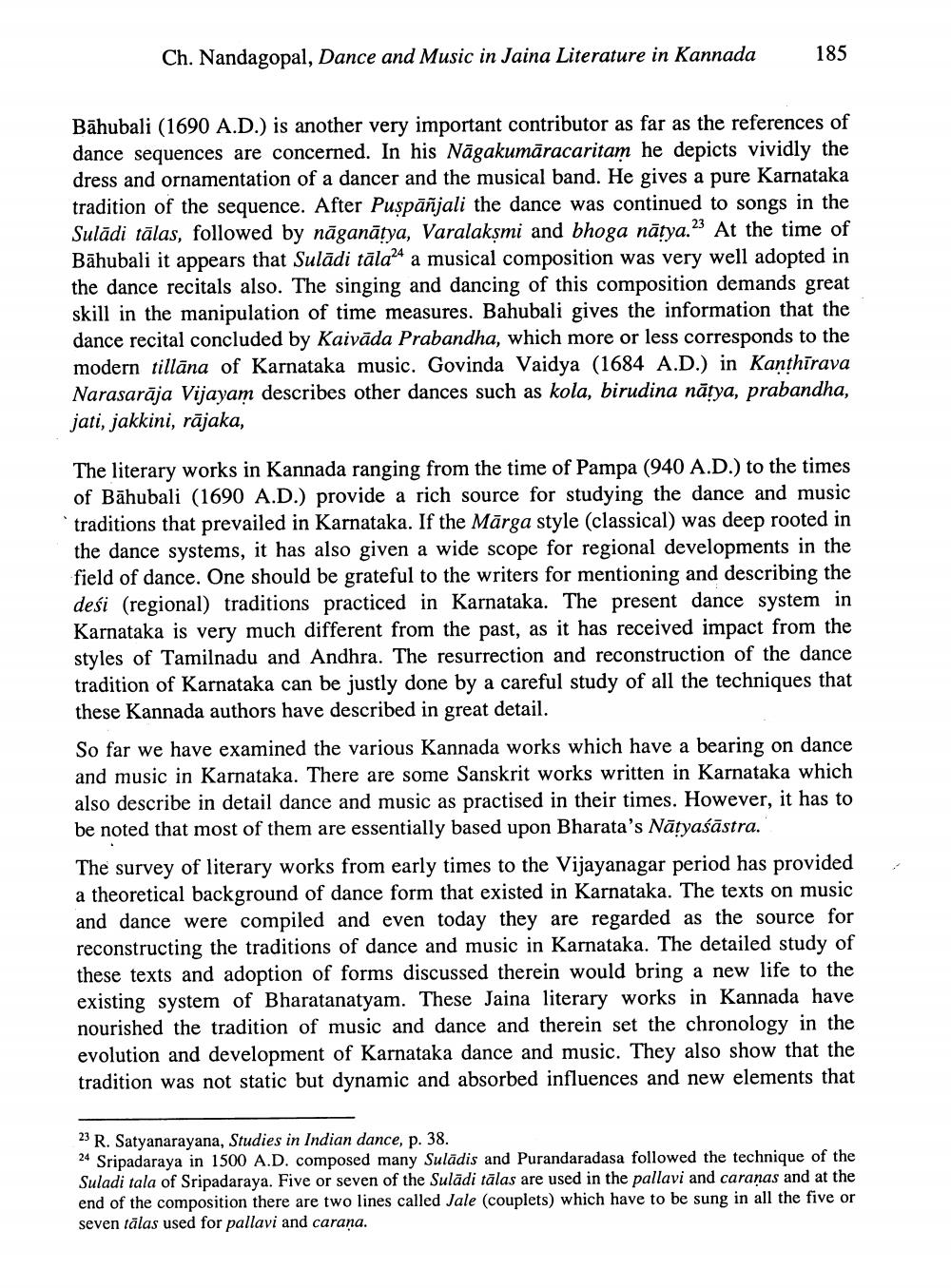________________
Ch. Nandagopal, Dance and Music in Jaina Literature in Kannada
185
Bāhubali (1690 A.D.) is another very important contributor as far as the references of dance sequences are concerned. In his Nāgakumāracaritam he depicts vividly the dress and ornamentation of a dancer and the musical band. He gives a pure Karnataka tradition of the sequence. After Puspāñjali the dance was continued to songs in the Sulādi tālas, followed by nāganātya, Varalaksmi and bhoga nātya.23 At the time of Bāhubali it appears that Sulādi tāla24 a musical composition was very well adopted in the dance recitals also. The singing and dancing of this composition demands great skill in the manipulation of time measures. Bahubali gives the information that the dance recital concluded by Kaivāda Prabandha, which more or less corresponds to the modern tillāna of Karnataka music. Govinda Vaidya (1684 A.D.) in Kanthirava Narasarāja Vijayam describes other dances such as kola, birudina nātya, prabandha, jati, jakkini, rājaka,
The literary works in Kannada ranging from the time of Pampa (940 A.D.) to the times of Bāhubali (1690 A.D.) provide a rich source for studying the dance and music traditions that prevailed in Karnataka. If the Mārga style (classical) was deep rooted in the dance systems, it has also given a wide scope for regional developments in the field of dance. One should be grateful to the writers for mentioning and describing the desi (regional) traditions practiced in Karnataka. The present dance system in Karnataka is very much different from the past, as it has received impact from the styles of Tamilnadu and Andhra. The resurrection and reconstruction of the dance tradition of Karnataka can be justly done by a careful study of all the techniques that these Kannada authors have described in great detail.
So far we have examined the various Kannada works which have a bearing on dance and music in Karnataka. There are some Sanskrit works written in Karnataka which also describe in detail dance and music as practised in their times. However, it has to be noted that most of them are essentially based upon Bharata's Nātyaśāstra.
The survey of literary works from early times to the Vijayanagar period has provided a theoretical background of dance form that existed in Karnataka. The texts on music and dance were compiled and even today they are regarded as the source for reconstructing the traditions of dance and music in Karnataka. The detailed study of these texts and adoption of forms discussed therein would bring a new life to the existing system of Bharatanatyam. These Jaina literary works in Kannada have nourished the tradition of music and dance and therein set the chronology in the evolution and development of Karnataka dance and music. They also show that the tradition was not static but dynamic and absorbed influences and new elements that
23 R. Satyanarayana, Studies in Indian dance, p. 38. 24 Sripadaraya in 1500 A.D. composed many Sulādis and Purandaradasa followed the technique of the Suladi tala of Sripadaraya. Five or seven of the Sulādi tālas are used in the pallavi and caranas and at the end of the composition there are two lines called Jale (couplets) which have to be sung in all the five or seven tālas used for pallavi and carana.




